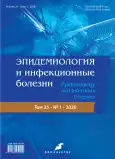Трудности первичной диагностики ВИЧ-инфекции на этапах оказания медицинской помощи
- Авторы: Эсауленко Е.В.1,2, Новак К.Е.1, Ингабире Т.1,2, Семёнова С.А.1, Никифорова А.О.1
-
Учреждения:
- Санкт-Петербургский государственный педиатрический медицинский университет
- Санкт-Петербургский научно-исследовательский институт эпидемиологии и микробиологии им. Пастера
- Выпуск: Том 25, № 1 (2020)
- Страницы: 11-17
- Раздел: ОРИГИНАЛЬНЫЕ ИССЛЕДОВАНИЯ
- URL: https://journals.rcsi.science/1560-9529/article/view/35187
- DOI: https://doi.org/10.17816/EID35187
- ID: 35187
Цитировать
Полный текст
Аннотация
Цель – продемонстрировать трудности и несвоевременность диагностики ВИЧ-инфекции врачами первичного звена здравоохранения, провести клинико-эпидемиологический анализ впервые выявленных случаев ВИЧ-инфекции.
Материал и методы. Проведены оценка маршрутизации, анализ эпидемиологических и клинико-лабораторных данных 85 пациентов с впервые установленным диагнозом ВИЧ-инфекции, госпитализированных в СПБ ГБУЗ «Клиническая инфекционная больница им. С.П. Боткина» в период с ноября 2018 г. по октябрь 2019 г. Для лабораторного подтверждения ВИЧ-инфекции использовался метод иммуноферментного анализа и иммунного блотинга.
Результаты исследования. Среди наблюдавшихся пациентов 71,3% составили женщины, 28,7% – мужчины. Средний возраст – 39,3 ± 2 года. При поступлении в инфекционный стационар с установленным диагнозом ВИЧ-инфекции в профильные отделения госпитализировано 49,5% (n = 42) больных, из них 9 пациентов поступили по направлению поликлиники с выявленной ВИЧ-инфекцией, у 20 пациентов диагноз был установлен в соматических стационарах, у 13 – врачами приемного покоя. Остальные 50,5% (n = 43) были направлены в различные отделения с другими диагнозами. Клинико-лабораторный анализ данных пациентов показал, что впервые в жизни установленный диагноз ВИЧ-инфекции соответствовал как ранним (15,3%), так и поздним (84,7%) стадиям заболевания с доминированием полового пути передачи вируса (43,6%).
Заключение. ВИЧ-инфекция как на ранних, так и на поздних стадиях может манифестировать под маской различных заболеваний, что делает необходимым широкое внедрение тестирования пациентов на ВИЧ-инфекцию, в том числе с использованием экспресс-тестов.
Ключевые слова
Полный текст
Открыть статью на сайте журналаОб авторах
Елена Владимировна Эсауленко
Санкт-Петербургский государственный педиатрический медицинский университет; Санкт-Петербургский научно-исследовательский институт эпидемиологии и микробиологии им. Пастера
Автор, ответственный за переписку.
Email: infection-gpmu@mail.ru
ORCID iD: 0000-0003-3669-1993
SPIN-код: 6210-0424
д.м.н., профессор, заведующая кафедрой инфекционных болезней взрослых и эпидемиологии
Россия, Санкт-ПетербургКсения Егоровна Новак
Санкт-Петербургский государственный педиатрический медицинский университет
Email: kseniya.novak@mail.ru
ORCID iD: 0000-0001-9633-4328
SPIN-код: 4026-3720
к.м.н., доцент кафедры инфекционных болезней взрослых и эпидемиологии
Россия, Санкт-ПетербургТьерри Ингабире
Санкт-Петербургский государственный педиатрический медицинский университет; Санкт-Петербургский научно-исследовательский институт эпидемиологии и микробиологии им. Пастера
Email: ingabire@mail.ru
ORCID iD: 0000-0002-3349-6271
SPIN-код: 5095-0230
аспирант кафедры инфекционных болезней взрослых и эпидемиологии
Россия, Санкт-ПетербургСофья Александровна Семёнова
Санкт-Петербургский государственный педиатрический медицинский университет
Email: infection-gpmu@mail.ru
ORCID iD: 0000-0002-0600-4438
SPIN-код: 2881-8789
старший лаборант кафедры инфекционных болезней взрослых и эпидемиологии
Россия, Санкт-ПетербургАлександра Олеговна Никифорова
Санкт-Петербургский государственный педиатрический медицинский университет
Email: infection-gpmu@mail.ru
ORCID iD: 0000-0001-7836-1883
SPIN-код: 8227-5510
студентка 6-го курса
Россия, Санкт-ПетербургСписок литературы
- Государственный доклад «О состоянии санитарно-эпидемиологического благополучия населения в Российской Федерации в 2018 году». — М.: Федеральная служба по надзору в сфере защиты прав потребителей и благополучия человека, 2019. — 254 с.
- Беляков Н.А., Рассохин В.В., Семенов А.В., и др. ВИЧ-инфекция и коморбидные состояния в Северо-Западном федеральном округе РФ в 2016 году. Аналитический обзор. — СПб.: НИИЭМ им. Пастера, 2017. — 52 с.
- Покровский В.В. ВИЧ-инфекция и СПИД. Национальное руководство. — М.: ГЭОТАР-Медиа, 2014. — 528 c.
- Ahlström M.G., Ronit A., Omland L.H., Vedel S., Obel N. Algorithmic prediction of HIV status using nation-wide electronic registry data. E Clinical Medicine. 2019;17:100203. doi: 10.1016/j.eclinm.2019.10.016.
- Late presenters working group in COHERE in EuroCoord; Mocroft A., Lundgren J., et al. Late presentation for HIV care across Europe: update from the Collaboration of Observational HIV Epidemiological Research Europe (COHERE) study, 2010 to 2013. Euro Surveill. 2015;20:47. doi: 10.2807/1560-7917.ES.2015.20.47.30070.
- HIV Causal Collaboration; Ray M., Logan R., et al. The effect of combined antiretroviral therapy on the overall mortality of HIV-infected individuals. AIDS (London, England). 2010;24(1):123–137. doi: 10.1097/QAD.0b013e3283324283.
- Ma Z.M., Stone M., Piatak M. Jr., et al. High specific infectivity of plasma virus from the pre-ramp-up and ramp-up stages of acute simian immunodeficiency virus infection. J Virol. 2009;83(7):3288–3297. doi: 10.1128/JVI.02423-08.
- Справка: ВИЧ-инфекция в Российской Федерации в первом полугодии 2019 г. Доступ по http://aids-centr.perm.ru/images/4/hiv_in_russia/hiv_in_rf_30.06.2019.pdf (дата обращения: 03.06.2019).
- Бартлетт Дж., Редфилд Р., Фам П., Мазус А.И. Клиничес-кие аспекты ВИЧ-инфекции. Российское издание. — М.: ГРАНАТ, 2013. — 696 с.
- Lin T.Y., Yang C.J., Liu C.E., et al. Clinical features of acute human immunodeficiency virus infection in Taiwan: a multicenter study. J Microbiol Immunol Infect. 2019;52(5):700–709. doi: 10.1016/j.jmii.2018.01.005.
- Rosenberg N.E., Pilcher C.D., Busch M.P., Cohen M.S. How can we better identify early HIV infections? // Curr Opin HIV AIDS. 2015;10(1):61–68. doi: 10.1097/COH.0000000000000121.
- Цыкин Д.Б., Ланцова Н.А., Щерба Ю.В., и др. Изменения внутренних органов при нарко- и токсикоманиях. Советская медицина. 1991;54(3):78–80.
- Новак К.Е. Клинико-морфологическая характеристика субкомпенсированного и декомпенсированного цирроза печени вирусной этиологии. Педиатр. 2011;2(2):47–52.
- Ермак Т.Н., Самитова Э.Р., Токмалаев А.К., Кравченко А.В. Современное течение пневмоцистной пневмонии у больных с ВИЧ-инфекцией. Терапевтический архив. 2011;11:19–24.
- Леванович В.В., Тимченко В.Н., Архипова Ю.А., и др. ВИЧ-инфекция на рубеже веков: Руководство для врачей всех специальностей. — СПб.: Издательство Н-Л, 2012. — 496 с.
- Lu W., Mehraj V., Vyboh K., et al. CD4:CD8 ratio as a frontier marker for clinical outcome, immune dysfunction and viral reservoir size in virologically suppressed HIV-positive patients. J Int AIDS Soc. 2015;18(1):20052. doi: 10.7448/IAS.18.1.20052.
- Miedzinski L.J. Early clinical signs and symptoms of HIV infection: delaying progression to AIDS. Can Fam Physician. 1992;38:1401–1410.
- Lang S., Mary-Krause M., Cotte L., et al. Impact of individual antiretroviral drugs on the risk of myocardial infarction in human immunodeficiency virus-infected patients: a case-control study nested within the French Hospital Database on HIV ANRS cohort CO4. Arch Intern Med. 2010;170(14):1228–1238. doi: 10.1001/archinternmed.2010.197.
Дополнительные файлы








